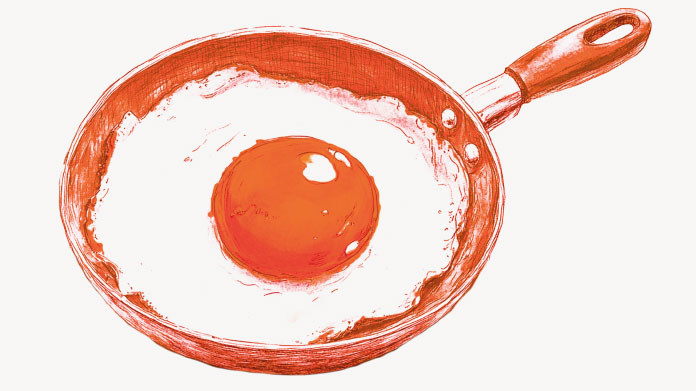Thonon diet: principles, advice and menus
Lose up to 10 kilos in a fortnight: that's the promise of the Thonon diet. With its high protein and low calorie content, this programme is provoking as much enthusiasm as questions. This article takes a closer look at its principles, its scientific value and its menus.

What is the Thonon diet?
Definition of the Thonon diet
The Thonon diet is a slimming programme that is high in protein and very low in calories.
It is attributed to a doctor at the hospital in Thonon-les-Bains, the town from which the diet takes its name.
The Thonon diet was initially designed to achieve rapid weight loss in patients preparing for surgery.
Today, it has been adopted by thousands of people looking for immediate results.
2 distinct phases
The Thonon diet is divided into 2 phases:
- a strict 14-day phase, based on a highly structured menu with little variety
- a stabilisation phase, during which food groups are gradually reintroduced
3 golden rules for this fast diet
This demanding diet is based on 3 major principles:
- a very low calorie intake (meals are limited to around 600 calories a day during the first phase, then 1200 to 1500 during the second)
- a high-protein diet
- a drastic exclusion of carbohydrates and fats
What science has to say about the Thonon diet
Benefits of this ultra-fast slimming diet
Many experts recognise the effectiveness of the Thonon diet.
The programme is renowned for its rapid results: the severe calorie restriction combined with a protein-rich diet stimulates significant weight loss in a short space of time.
However, many scientists point to significant shortcomings that can damage health in the long term.
Numerous side effects
The concept of this diet has some major drawbacks:
- The drastic calorie restriction generates a sudden weight loss, which is not always well tolerated. The Thonon diet can cause serious side effects such as a sharp drop in energy, constipation, headaches, nausea, etc.
- The almost total elimination of carbohydrates, fats and numerous micronutrients exposes people to nutritional deficiencies in magnesium, calcium, iron, vitamins B1, D, E, omega-3, omega-6, etc.
- Although it favours animal protein sources, the diet does not provide enough protein to cover an adult's needs. An energy intake that is too low (3 to 4 times lower than that normally recommended for an adult!) results in a shortage of proteins, the essential macronutrients used to manufacture our body's tissues, enzymes and hormones. This can lead to muscle wasting.
- The lack of calories can also lead to a reduction in bone mass, metabolic and kidney dysfunctions and cardiovascular problems.
- The potential psychological impact of this diet also needs to be taken into account, as the eating plan is extremely monotonous and difficult to follow. In terms of logistics, it complicates the daily and social lives of those who follow it.
- You also need to be able to resist the frustrations and cravings that this type of diet will inevitably create, without altering either the content or the order of the meals.
- The lack of variety and dietary fibre can deplete the intestinal microbiota, which can hamper digestion and lead to gastric discomfort.
- The diet can even be counter-productive, encouraging rapid weight regain. In fact, when we stop covering our usual daily needs, our body starts to store everything it can to build up reserves and ensure its survival. This is how the famous ‘yo-yo’ effect, well known to dieters, is created.
- Finally, it can trigger risky behaviour in vulnerable individuals, such as orthorexia or anorexia.
Caution is therefore still called for
Experts therefore recommend a cautious approach to this type of programme.
To feel better about your body and regain a healthy weight in the long term, it is generally considered preferable to analyse your eating behaviour, understand your real needs and opt for a gradual nutritional rebalancing.
We advise you to consult a health professional before embarking on such a restrictive diet, especially if you suffer from chronic illnesses, diabetes or eating disorders.
The Thonon diet is not recommended for pregnant women, the elderly, children or adolescents.
The Thonon diet menus
Which foods are preferable and which are not?
Because of its highly restrictive nature, the Thonon diet does not allow for much dietary diversity.
You can eat lean meat (chicken, turkey, fillet mignon, veal, cooked ham, etc.), white fish, seafood, eggs, green vegetables, low-sugar fruit, 0% yoghurts and dairy products, herbs and spices, and sugar-free coffee and tea.
Most starchy foods, refined cereals, ready meals, biscuits, cakes, pastries, sweets, soft drinks and alcohol should be avoided.
Menus for phase 1
Here are 3 examples of menus that comply with the strict principles of the initial phase of the Thonon diet: each day is calculated to stay within the 600-calorie range.
These meals, rich in protein and very low in carbohydrates and fats (compared with the usual recommended intake), illustrate the rigour imposed by this programme.
Day 1 (approx. 600 kcal)
- Breakfast: 1 cup of sugar-free tea or coffee + half a grapefruit.
- Lunch: 2 boiled eggs + as much spinach as you like (no salt or fat).
- Dinner: as much cooked ham as you like (no fat).
Day 2 (approx. 600 kcal)
- Breakfast: 1 cup of sugar-free tea or coffee + a little milk.
- Lunch: fish cooked in court-bouillon + 2 tomatoes (no salt or fat).
- Dinner: 1 grilled steak + green salad with lemon or olive oil.
Day 3 (approx. 600 kcal)
- Breakfast: 1 cup of sugar-free tea or coffee + grated unseasoned carrots.
- Lunch: as much grilled chicken as you like (no salt or fat).
- Dinner: as much ham + as much fruit as you like + 0% plain yoghurt.
These menus comply with the Thonon diet guidelines in the strict phase, but their low calorie content requires particular vigilance to avoid side effects linked to nutritional deficiencies.
Phase 2 menus
During this second phase, you can gradually reintroduce different foods, based on the following recommendations:
- Breakfast: 1 sugar-free hot drink, 1 low-fat yoghurt or 1 glass of skimmed milk, 1 slice of wholemeal bread with 10g margarine, 1 piece of fresh fruit.
- Lunch: 100 to 200g of your choice of raw vegetables, with 1 teaspoon of vegetable oil, 100 to 150g of fish or lean meat, 100 to 200g of your choice of green vegetables, 100g of unsweetened fromage frais and a piece of fresh fruit.
- Snack (optional): 1 hot sugar-free drink, 1 0% fat yoghurt.
- Dinner: 1 bowl of homemade vegetable soup, 100 to 150 g of fish or meat, 100 to 200 g of green vegetables, 1 small potato, 1 slice of wholemeal bread and 10 g of margarine, 1 small piece of fruit.
What food supplements should I use for the Thonon diet?
Whey can be incorporated into your recipes to help you fill up on the protein recommended by the diet (opt for Native Whey Protein Isolate, which contains 92% protein).
To reduce the risk of nutritional deficiencies and fatigue associated with such a diet, you can also take a multivitamin food supplement (such as Daily 3®) and a magnesium supplement (such as Magnesium Malate).
Omega-3s are also excellent allies in helping you maintain your general health (see our Super Omega 3) (1).
Adopting an appetite suppressant food supplement can also help you to limit your appetite and therefore your intake (as in the case of CSAT®, made from natural carob extract).
You can also opt for a 'fat-burning' slimming food supplement to reinforce the effects of your diet (such as Advanced Fat Burner).
Also consider probiotics to support the balance of your intestinal microbiota and therefore help compensate for the intestinal problems potentially caused by the Thonon diet. Opt for Lactobacillus gasseri, for example, which has shown promising results in terms of its ability to reduce abdominal fat (see Lactobacillus Gasseri) (2).
SUPERSMART ADVICE
References
- Danielle Swanson, Robert Block, Shaker A. Mousa, Omega-3 Fatty Acids EPA and DHA: Health Benefits Throughout Life, Advances in Nutrition, Volume 3, Issue 1, 2012, Pages 1-7, ISSN 2161-8313, https://doi.org/10.3945/an.111.000893.
- Gul, S.; Durante-Mangoni, E. Unraveling the Puzzle: Health Benefits of Probiotics—A Comprehensive Review. J. Clin. Med. 2024, 13, 1436. https://doi.org/10.3390/jcm13051436.
2 Days
The products I use are excel·lent
The products I use are excel·lent
ROSAS Josep Maria
10 Days
Delivery is prompt and I never saw a…
Delivery is prompt and I never saw a quality problem with the manufacturing. It is not possible to assess efficacy on a personal basis, since too many factors come into play. Efficacy can only be assessed statistically with a sufficient number of cases.
Roger De Backer
11 Days
I collaborates with the Supersmart…
I collaborates with the Supersmart more than 10 years. Every thing is going good. Quality of the things is good. Delivery comes in time. Five stars definitely !!!
Oleksiy
11 Days
All good
Simple, frictionless site, easy ordering, good delivery updates and execution.
Chris Robbins
13 Days
I feel better
I feel better
Peter Ammann
14 Days
Prompt delivery
Prompt delivery
JAKUB Radisch
15 Days
My new go-to for top quality supplements!
I am buying more and more of my supplements from this superb, high quality company. Cannot recommend it enough. Plus, excellent customer service with a quick, helpful team and speedy deliveries. Highly recommend Supersmart!
Cecilie H.
19 Days
SUPERSMART WHAT ELSE👍
SUPERSMART WHAT ELSE👍
DIEDERLE Christophe
21 Days
Excellent quality products with…
Excellent quality products with innovative formulas, as someone who has been suffering with acid reflux, these supplements have been lifesavers.
Oriana Moniz
22 Days
high quality supplement!
high quality supplement!
GALANT
22 Days
Good service prompt delivery
Good service prompt delivery
Mrs Marcella Reeves
27 Days
I like your clear explanation
I like your clear explanation. And how to make a choice of products for a specific health problem
Ingrid
33 Days
Great product and it arrives quickly.
Great product and it arrives quickly.
SOMMARIVA Gianni
35 Days
Excellent products and fast service.
Excellent products and fast service. What do we need more?
Margarida
39 Days
The variety of products is amazing
The variety of products is amazing, the offers are good and the sending is very fast. I just miss having a bit more of guidance about combinations, possible interactions, etc.
Maria Angeles Verdu




